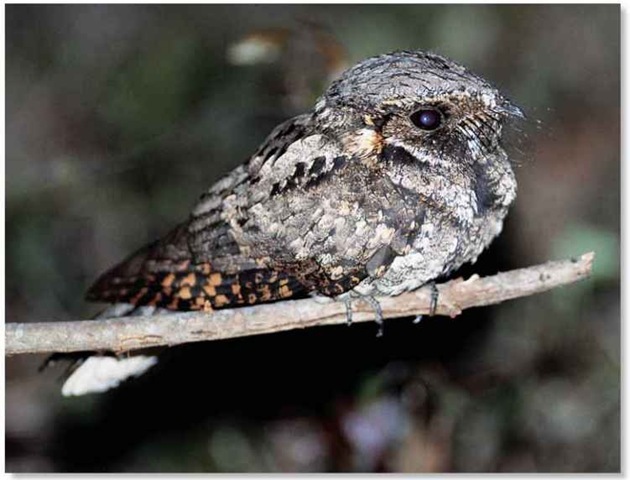ORDER
Caprimulgiformes
FAMILY
Caprimulgidae
GENUS & SPECIES
key features
Patterned plumage provides the perfect camouflage during the day
Feeds exclusively on insects, which it catches in flight with its wide mouth Best distinguished by its call, a loud “whip-poor-will”‘ leading to its common name
where in the world?
Found in North America from southeast Canada through the central and eastern U.S.; also the southwest U.S. to Mexico and Costa Rica

LIFECYCLE
With swift and agile flight, the voracious whippoorwill hunts nocturnal insects, such as moths, and rapidly catches and eats its fast-moving prey in flight.
HABITAT
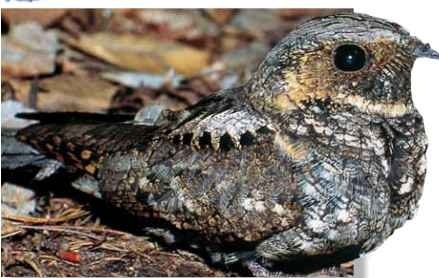
A Forest floor The whippoorwill is most often found perching on the ground.
Throughout its range from Canada to Central America, the whippoorwill is widely distributed and is most common in the country, where it prefers the ungrazed woodlots and woodlands usually associated with farms. Its rural habitat also includes the dense deciduous and coniferous forests along mountains and canyons in the southern U.S. The whippoorwill commonly perches on the ground or lengthwise on the branch of a tree, where it uses its concealing plumage to become part of the scenery in order to avoid predators.
The whippoorwill’s reproductive cycle coincides with the lunar cycle; young are born under full moons. This enables the adults to forage easily to feed nestlings.
The whippoorwill calls at a rate of one call per second; the record for the most consecutive number of calls is 1,088 counted by ornithologists in the field.
BREEDING
Breeding begins in May and lasts until August.During this time, the male whip-poor-will uses his call to locate a mate and to challenge any rivals.The male also performs several courtship displays. He quietly approaches the female while bobbing his head and purring as he circles her; he may also show her the large white patches in his tail. Once the female has accepted his advances, the pair mates. The female lays two eggs on the open floor in the woods.Since her plumage blends so perfectly with the dead leaves on the ground, she uses no other means of concealment and incubates her eggs for 7-20 days, usually without ever being discovered. The male abandons the female after mating, so she is on her own during incubation and must provide all the food for the nestlings. When the female leaves to hunt, the nestlings sit on the ground and also blend well.The young leave the nest about 20 days after hatching.
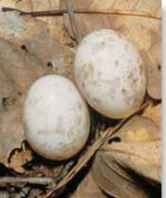
A No nest
Eggs are laid on the ground with no cover.
Hiding place The chick’s downy feathers are quickly replaced with the streaked plumage.
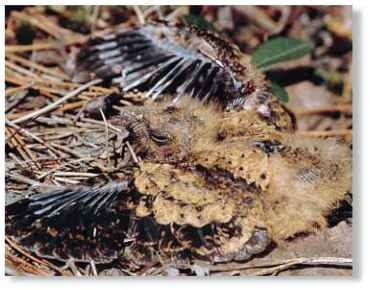
FOOD & FEEDING
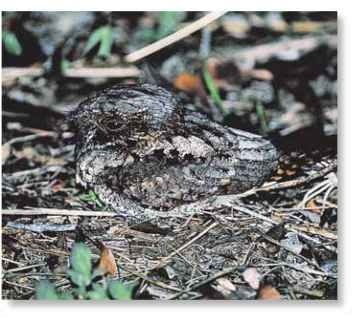
The whippoorwill emerges after dark to feed on flying insects. Flying close to the ground with its mouth wide open, the whippoorwill uses its acute vision to forage for prey. It catches large numbers of insects quickly and efficiently feeding mostly on large moths. Other prey includes beetles, grasshoppers, caterpillars, crickets and mosquitoes.
INSECT PURSUIT

Scanning…
Perched on a dead branch, the whippoorwill begins its nightly feeding rounds, scanning the area for prey.
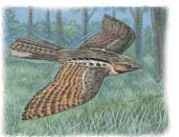
Flying…
The whippoorwill leaves its perch and flies low, just above the ground, in the clearing of a mixed woodland.

Pursuing…
Spotting a large moth, the whippoorwill swiftly pursues it, with its mouth wide open, flying just below the top of the grass.
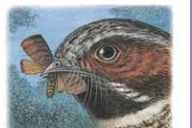
Devouring
With swift flight, the whippoorwill closes in fast and snaps up the moth in one swift gulp, swallowing it whole.
CONSERVATION
The whippoorwill is not globally threatened, but its numbers are declining due to habitat destruction: the forests throughout its range are being cleared for human development.The whipoorwill is listed on Canada’s Blue List and, like all members of the Caprimulgidae family, it is protected by United States law, and a permit is required to keep it in captivity.
BEHAVIOR
Like all members of its family, the whippoorwill is nocturnal and relies upon its cryptic plumage to remain hidden during the day. A master of camouflage, it spends the day perched on the ground or lengthwise on a branch of a tree, blending almost completely with its surroundings. This bird hides so well that it is seldom seen by day and is more commonly known by its song heard at night: a loud, rapidly repeated, whip-poor-will.
The whippoorwill is frequently found at night along the sides of roads taking a dust bath. This ritual removes excess oil and moisture from its feathers.
No worries
The whippoorwill’s plumage helps it hide from danger.

Profile
Whippoorwill
With its long, pointed wings, the whippoorwill darts through the air to chase insects with the speed and skill of a bat.
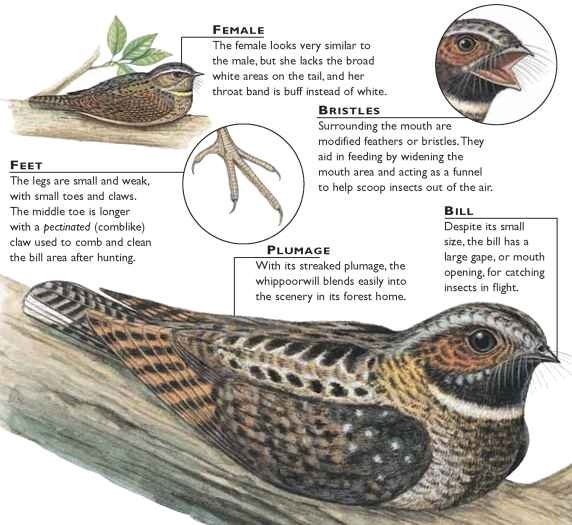
CREATURE COMPARISONS
A close relative of the whippoorwill, the scissor-tailed nightjar (Hydropsalis brasiliana) is native to the tropical and subtropical zones of South America from Peru south to Argentina. Both birds have camouflaging plumage, but the nightjar lacks the white wing stripe visible from below when in flight.The scissor-tailed nightjar also has very long, forked tail feathers that reach up to 6″ in length, compared to the short, round tail of the whippoorwill. At a maximum length of 20″, including the tail, the nightjar is much larger than its cousin, but the tail accounts for almost two-thirds of the nightjar’s total length.
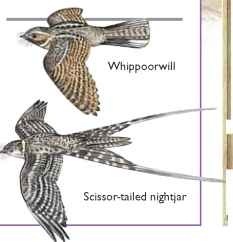
| vital | |
| statistics | |
| Weight | 1.5-2.5 oz. |
| Length | 9-10″ |
| Wingspan | 16-19.5″ |
| Sexual Maturity | 1 year |
| Breeding Season | May-August |
| Number of Eggs | 2 |
| Incubation PERIOD |
17-20 days |
| Fledging Period | About 20 days |
| Birth Interval | 1 year; sometimes 2 broods |
| per year | |
| Typical f Diet | Insects, especially moths |
| Lifespan | Unknown |
Related species
• The whippoorwill belongs to the nightjar family, Caprimulgidae, which contains about 72 species in 16 genera. All of the members look very similar, with camouflaging plumage. The genus Caprimulgus is the largest in the family with 45 . species, including the | chuck-will’s-widow, C. carolinensis, the dusky nightjar, C. pectoralis and | the European nightjar, IC. europaeus.
